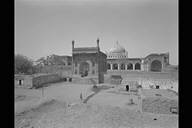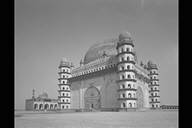
¨Detailed Explanation
¨Plan and List of photos
The Gate and The player hall
BIJAPUR
@The first ruler of the Adil Shahi Dynasty
announced its independence from the Baihmani Dynasty and built
the round fort at the centre of the city in the early 16th
century. Surrounding the fort, the city expands in an oval shape.
Its city walls with 5 gates were constructed in the period of the
5th Ali Adil Shah. In the Adil Shahi Dynasty from the 16th to the
end of 17th century, it saw prosperity as the capital and
numerous Islamic architecture was constructed, one can still
observe. To the south of a broad road running from the east to
the west, connecting the central fort and the east gate, Jama
Masjid is situated. In addition to a number of mosques, the
rulers of the Adil Shahi Dynasty, especially those after the 5th
ruler, were keen on constructing their own tombs. Among them,
Ibrahim Rauza entombing the 6th sultan Ibrahim, and Gol Gumbaz,
entombing the 7th Muhammmad are well-known. Ibrahim Rauza is
situated in the western outskirts of Bijapur and Gol Gumbaz is in
the east end within the city walls. (Naoko Fukami)
@
1.JAMA MASJID (1576)
2.GOL GUMBAZ (c.1655)
 |
@This mosque is
built in the southeast part of Bijapur city and it is one
of the largest remains of the Adil Shahi Dynasty. At the
east side of the mosque, there is an entrance gate with
rooms on either side. There is a small entrance in the
south, and in the north a gate projects on a considerable
scale. The prayer room is situated in the west possesses
9 arched entrances. The depth is 5 spans, creating a
large space that is capable of containing many religious
faithful as Jama Masjid. The large dome above the prayer
room is on a basement shaped like a drum, providing lines
of small arch-shaped niches, a battlement and small
towers. As with as the front of the prayer room, the
white exterior of the mosque has almost no decoration,
creating the tidy atmosphere of this Jama Masjid. Inside
the walls to the south and the north, the corridor like
rooms are built projecting out from the prayer room.
Viewing from the front entrance to the east side, the
discontinued corridor of this part emphasizes the majesty
of the exterior of this mosque further. In the centre
part of the court yard, a water tank of considerable
scale is positioned. (Matsuo Ara) ¨Detailed Explanation ¨Plan and List of photos |
| £View from the
nourtheast The Gate and The player hall |
|
@
 |
@It is not
overstating the matter to say that Bijapur is known
because of this huge historical monument; it is the most
famous building in South Asia. Its semicircular dome is
often compared with St. Paul's in London in terms of
size, and the width of the tomb chamber (18338 sq. feet)
with the Pantheon in Rome (15833 sq. feet), as the former
is much bigger than the latter. "Gol" means
"round" and "Gumbaz" came from
"Gumbad" meaning "dome" or
"domed building", so the name merely suggests
"round domed building". Known for its huge scale, this building was constructed during his life time by Muhannmad Adil Shah (reign 1627-55), who was the most powerful leader in Bijapur history. It is said that he died before its plaster work was completed, or in other words, before his tomb was accomplished. (Matsuo Ara) ¨Detailed Explanation ¨Plan and List of photos |
| @£View from the
southeast The mosque and the Tomb |
|
@@@@@@@@@@@@@